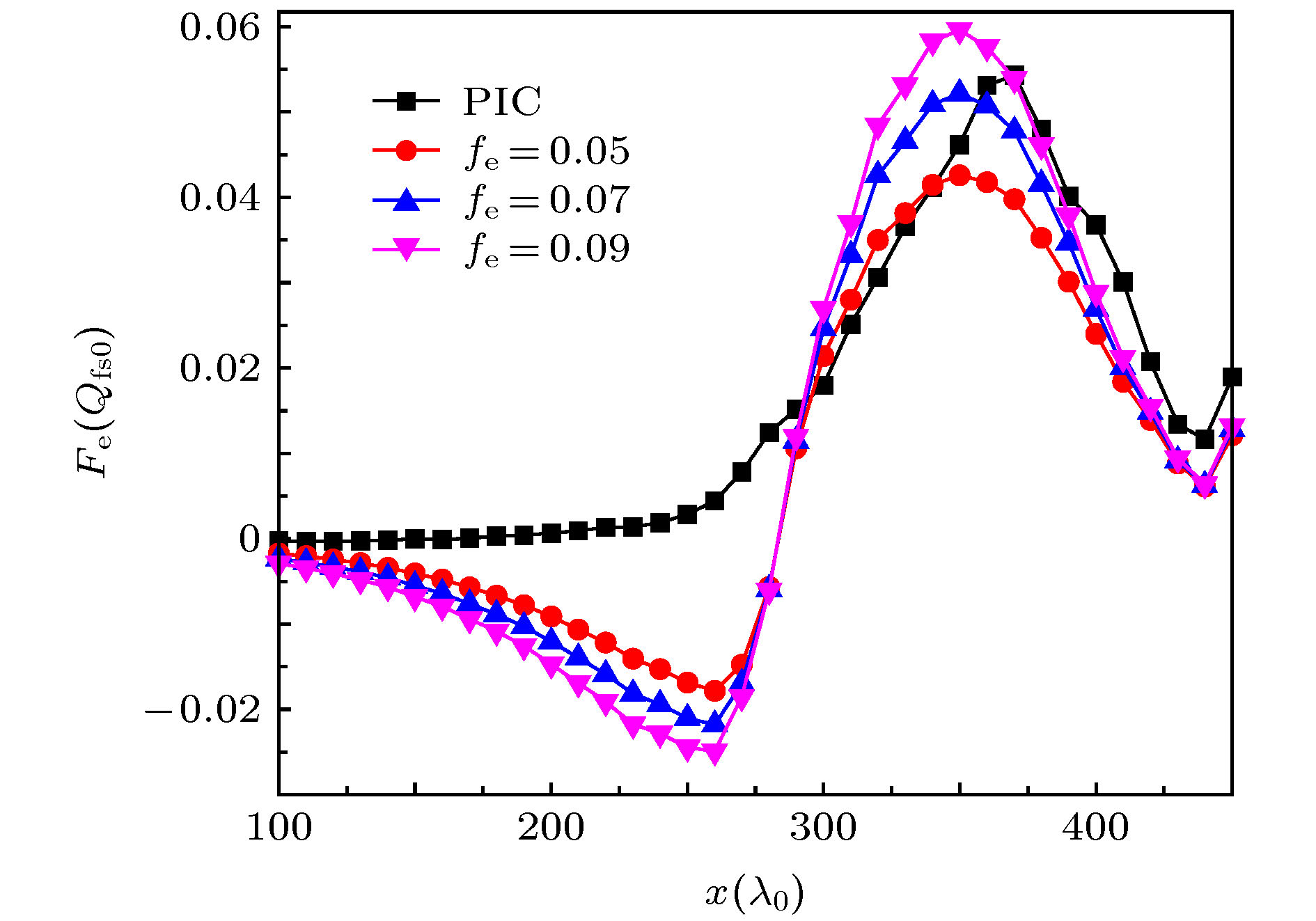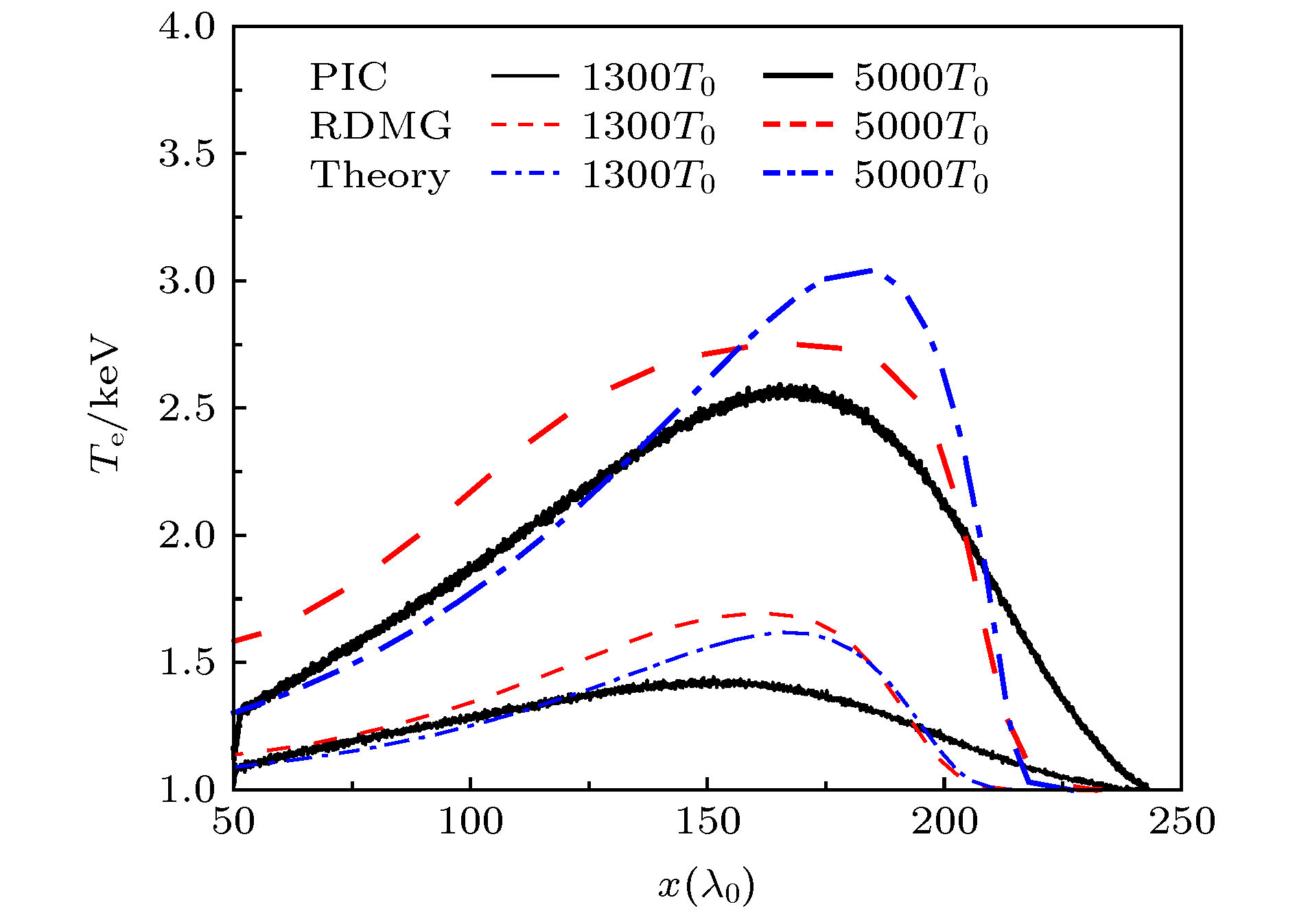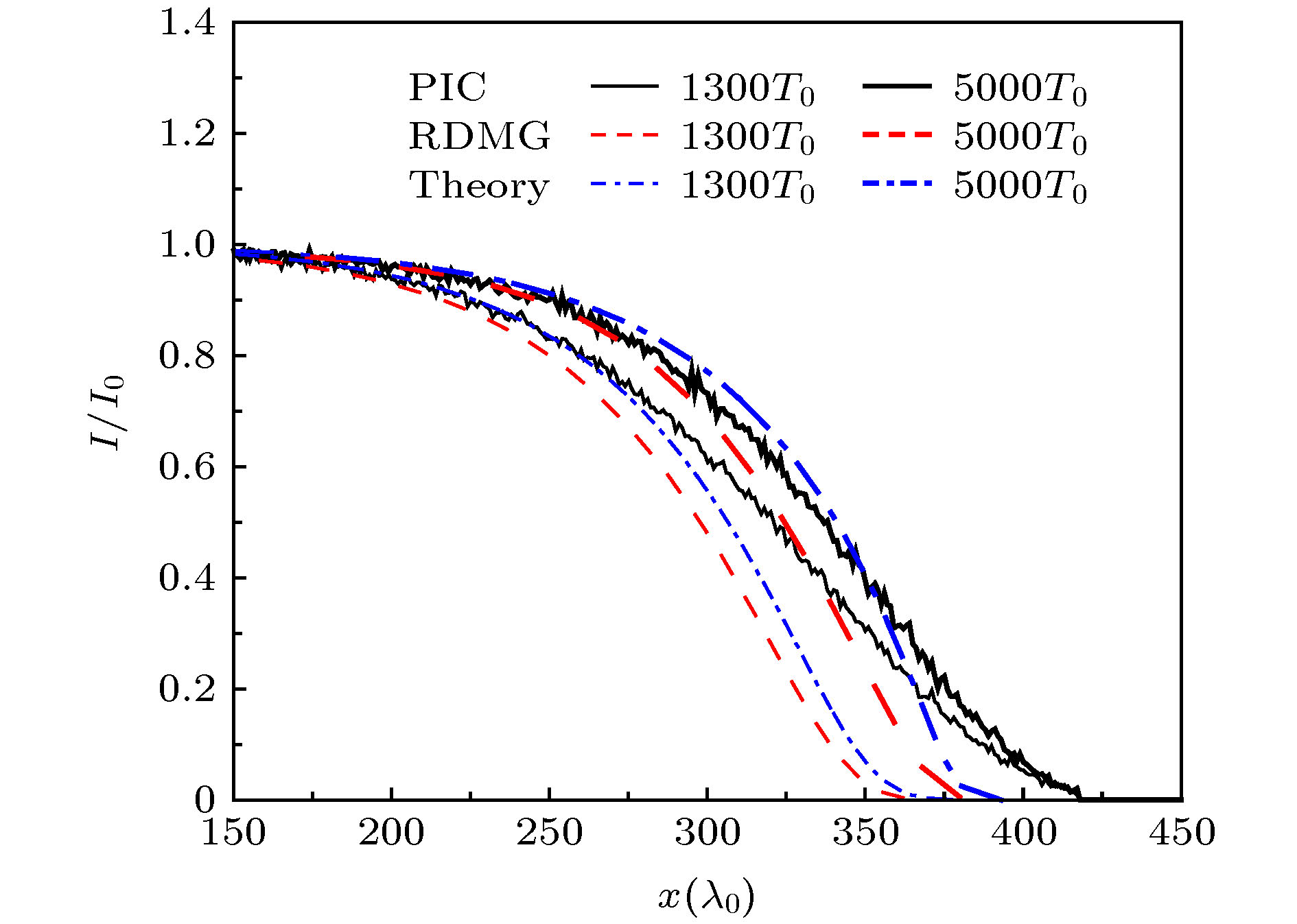-
辐射流体采用限流的局域Spitzer-Härm (S-H)电子热流近似, 在预估等离子体状态时可能与实验观察存在偏差. 利用一维(1D3V)含碰撞的粒子模拟程序, 研究了激光聚变黑腔中金等离子体的电子分布函数和电子热流. 分析表明, 在等离子体的冕区,
$\alpha=Z(v_{\rm{os}}/v_{\rm{te}})^2 > 1$ , 电子分布函数表现为超高斯分布(m = 3.34), 克努森数$\lambda_{\rm{e}}/L_{\rm{e}}=0.011$ 大于局域S-H理论的临界值$2\times10^{-3}$ . 这导致了局域S-H电子热流远大于实际热流. 这种实际热流受限现象将导致辐射流体模拟给出的冕区电子温度高于神光实验测量值. 而在等离子体的高密度区域, 电子分布函数仍表现为超高斯分布(m = 2.93), 克努森数$\lambda_{\rm{e}}/L_{\rm{e}}=7.58\times10^{-4}$ 小于局域S-H理论的临界值, 限流的局域S-H电子热流具有一定的适用性. 但电子热流严重依赖于限流因子$f_{\rm{e}}$ , 辐射流体模拟需要根据不同位置的光强和电子温度调整$f_{\rm e}$ 的大小.When evaluating the plasma parameters in inertial confinement fusion, the flux-limited local Spitzer-Härm (S-H) model in radiation hydrodynamics simulations may be invalid when electron temperature gradient is too large. In other publications, the electron distribution function (EDF) could be explained by comparing the energy equipartition rate$R_{\rm eq}=\dfrac{1}{2}m_{\rm e}v_{\rm te} ^2\nu_{\rm ee}$ with the heating rate$R_{\rm heat}=\dfrac{1}{2}m_{\rm e}v_{\rm os} ^2\nu_{\rm ei}$ . When the condition$R_{\rm heat}\sim R_{\rm eq}$ is satisfied, the EDF deviates from Maxwell equilibrium distribution, and is well fitted to the super-Gaussian distribution$f({{ v}})=C_m{\rm e}^{-(v/v_m)^m}$ with the index m ($2<m<5$ ). The number of energetic electrons of the super-Gaussian distribution is less than that of the Maxwell distribution, which plays an important role in electron heat flux, especially for electrons of 3.7$v_{\rm te}$ . So electron heat flux of the super-Gaussian distribution is smaller than that of the Maxwell distribution. In this paper, EDF and electron heat flux in laser-produced Au plasma are simulated by using 1D3V PIC code (Ascent). It is found that in the coronal region, the laser intensity is larger, and the electron temperature is lower than the high-density region. So$\alpha=Z(v_{\rm os}/v_{\rm te})^2>1$ ,$R_{\rm heat}>R_{\rm eq}$ , the EDF is well fitted to super-Gaussian distribution, where the index m is evaluated to be 3.34. In this region, the large electron temperature gradient leads to a small temperature scale length ($L_{\rm e}=T_{\rm e}/(\partial T_{\rm e}/\partial x)$ ), but the low e-e and e-i collision frequencies lead to a large electron mean-free-path ($\lambda_{\rm e}$ ). So the Knudsen number$\lambda_{\rm e}/L_{\rm e}$ is evaluated to be 0.011, which is much larger than the critical value$2\times10^{-3}$ of the S-H model, flux-limited local S-H electron heat flux is invalid. As a result, the limited-flux S-H predicts too large an electron heat flux, which results in much higher electron temperature of radiation hydrodynamics simulation than that of SG experiments. This heat flux inhibition phenomenon in coronal region cannot be explained by the flux-limited local S-H model, and non-local electron heat flux should be considered. In the high density region, the laser intensity is weaker, and the electron temperature is higher, so$\alpha=Z(v_{\rm os}/v_{\rm te})^2<1$ ,$R_{\rm heat}<R_{\rm eq},$ but EDF is still well fitted to super-Gaussian distribution, where the index m is evaluated to be 2.93. In this region,$L_{\rm e}$ is larger,$\lambda_{\rm e}$ is smaller, so the Knudsen number is smaller, which is evaluated to be$7.58\times10^{-4}<2\times10^{-3}$ . As a result, The flux-limited local S-H electron heat flux is valid. However, the electron heat flux depends on the flux limiting factor ($f_{\rm e}$ ) that varies with laser intensity and electron temperature.-
Keywords:
- electron distribution function /
- Knudsen number /
- heat flux inhibition /
- flux limiting factor
[1] Lindl J 1995 Phy. Plasma 2 3933
 Google Scholar
Google Scholar
[2] Hinkel D E, Edwards M J, Li Y T, et al. 2013 Plasma Phys. Controlled Fusion 55 124015
 Google Scholar
Google Scholar
[3] Batani D, Baton S, Casner A, et al. 2014 Nucl. Fusion 54 054009
[4] Kirkwood R K, Moody J D, Kline J, et al. 2013 Plasma Phys. Controlled Fusion 55 103001
 Google Scholar
Google Scholar
[5] Spitzer L, Härm R 1953 Phys.Rev. 89 977
 Google Scholar
Google Scholar
[6] Hurricane O A, Callahan D A, Springer P T, et al. 2019 Plasma Phys. Controlled Fusion 61 014033
[7] Hall G N, Jones O S, Strozzi D J, et al. 2017 Phys. Plasmas 24 052706
 Google Scholar
Google Scholar
[8] Decker C D, Mori W B, Dawson J M, et al. 1994 Phys. Plasmas 1 4043
 Google Scholar
Google Scholar
[9] Porshnev P, Bivona S, Ferrante G 1994 Phys. Rev. E 50 3943
 Google Scholar
Google Scholar
[10] Fourkal E, Bychenkov V Y, Rozmus W, et al. 2001 Phys. Plasmas 8 550
 Google Scholar
Google Scholar
[11] Matte J P, Lamoureux M, Moller C, et al. 1988 Plasma Phys. and Controlled Fusion 30 1665
 Google Scholar
Google Scholar
[12] Liu J M, Groot J S, Matte J P, et al. 1994 Phys. Rev. Lett. 72 2717
 Google Scholar
Google Scholar
[13] Langdon A B 1980 Phys. Rev. Lett. 44 575
 Google Scholar
Google Scholar
[14] Bendib A 2017 Phys. Plasmas 24 070702
 Google Scholar
Google Scholar
[15] Weng S M, Sheng Z M, Zhang J 2009 Phys. Rev. E 80 056406
 Google Scholar
Google Scholar
[16] Mora P, Yahi H 1982 Phys. Rev. A 26 2259
 Google Scholar
Google Scholar
[17] Bibi F A, Matte J P 2002 Phys. Rev. E 66 066414
 Google Scholar
Google Scholar
[18] Holstein P A, Delettrez J, Skupsky S, Matte J P 1986 J. Appl. Phys. 60 2296
 Google Scholar
Google Scholar
[19] Epperlein E M, Short R W 1991 Phys. Fluids B 3 3092
 Google Scholar
Google Scholar
[20] Zhu S P, Gu P J 1999 Chin. Phys. Lett. 16 520
 Google Scholar
Google Scholar
[21] 赵斌, 郑坚 2012 中国科学: 物理学 力学 天文学 42 1196
 Google Scholar
Google Scholar
Zhao B, Zheng J 2012 Sci. Sin. Phys. Mech. Astron. 42 1196
 Google Scholar
Google Scholar
[22] 朱少平, 古培俊 1999 强激光与粒子束 11 687
Zhu S P, Gu P J 1999 High Power Laser Part. Beams 11 687
[23] Klimo O, Tikhonchuk V T, Ribeyre X, et al. 2011 Phys. Plasmas 18 082709
 Google Scholar
Google Scholar
-
图 1 电子的能量分布函数(PIC统计的电子分布函数严重偏离了同一个温度对应的麦克斯韦平衡分布, 而在低能段与相应的超高斯分布非常符合, 其中
$0.02\ n_{\rm c}\;(100\lambda_0)$ 处Te = 1.53 keV, α = 1.49, m = 3.34;$0.23\;n_{\rm c}\;(300\lambda_0)$ 处Te = 2.52 keV, α = 0.66, m = 2.93; 在高能段, 电子分布函数介于麦克斯韦分布和超高斯分布之间, 这部分电子对热流贡献最大)Fig. 1. Electron distribution function (dotted lines) from PIC simulation in comparison with a Maxwell equilibrium distribution (dashed and dotted lines) and a super-Gaussian distribution (solid lines). The low-energy electron distribution from PIC simulation is well fitted to the super-Gaussian distribution. PIC simulation shows that the number of energetic electrons (
$3 v_{\rm {te}} - 4 v_{\rm {te}} $ ) is more than that from Maxwell equilibrium distribution, but less than that from super-Gaussian distribution. These energetic electrons play an important role in electron heat flux.图 2 等离子体中的电子热流
${{F}}_{\rm e}$ (热流以$(1\;n_{\rm c}, 1\;{\rm{keV}})$ 对应的电子自由流$Q_{\rm{fs0}}=1.936\times10^{19}\;{\rm J}/({\rm{cm}}^2\cdot {\rm{s}})$ 为单位; 限流的S-H电子热流无法解释等离子体冕区存在的热流受限现象, 而与高密度区域的电子热流比较符合; 但电子热流严重依赖于限流因子$f_{\rm{e}}$ , 需要根据不同位置的光强和电子温度调整$f_{\rm{e}}$ 的大小)Fig. 2. Electron heat flux (black line) from PIC simulation in comparison with that from flux-limited S-H model for
$f_{\rm{e}}=0.05, 0.07, 0.09$ . The unit of the electron heat flux${{F}}_{\rm{e}}$ is the electron free stream Qfs0 (1nc, 1 keV) = 1.936 × 1019 J/(cm2·s). In the high density region, the electron heat flux from the limited S-H agrees well with PIC simulation result. But in the coronal region, the electron heat flux from the flux-limited S-H is much larger than that from PIC simulation.图 3 电子温度的空间分布(上方三条粗线对应
$5000T_0$ , 下方三条细线对应$1300T_0$ , 蓝色点线Theory表示无热流的光路追踪理论模型; 等离子体冕区温度梯度大, 克努森数超过临界值, 限流的局域S-H电子热流无法准确描述电子热流, 造成了RDMG对冕区电子热流的高估, 从而高估了电子温度; 高密度部分区域由于实际IBA系数低于理论值, 导致RDMG和无热流光路追踪模型估计的电子温度高于PIC结果)Fig. 3. Electron temperature from PIC simulation (solid lines) in comparison with that from radiation hydrodynamic simulation RDMG (dashed lines) and that from the optical path tracking model without heat flux (dashed and dotted lines). In the coronal region, the limited-flux S-H predicts too large electron heat flux and results in too high electron temperature from RDMG.
图 4 等离子体中的光强衰减图(上方三条粗线对应
$5000T_0$ , 下方三条细线对应$1300T_0$ , 蓝色点线Theory表示无热流的光路追踪理论模型; 由于高密度区域实际IBA系数低于理论值, 导致RDMG和无热流光路追踪模型高估了能量沉积, 激光衰减更快而无法到达临界面)Fig. 4. Decay curves of laser intensity from PIC simulation (solid lines) in comparison with that from radiation hydrodynamics simulation RDMG (dashed lines) and that from the optical path tracking model without heat flux (dashed and dotted lines). In the high density region, the inverse Bremsstraws absorption coefficient is smaller than the classical expression
$\kappa_{\rm{s}}=\dfrac{\nu_{\rm{ei}}}{c}\dfrac{n_{\rm{e}}/n_{\rm{c}}}{\sqrt{1-n_{\rm{e}}/n_{\rm{c}}}}$ , so the laser intensity from PIC simulation is higher than that from RDMG and the optical path tracking model. -
[1] Lindl J 1995 Phy. Plasma 2 3933
 Google Scholar
Google Scholar
[2] Hinkel D E, Edwards M J, Li Y T, et al. 2013 Plasma Phys. Controlled Fusion 55 124015
 Google Scholar
Google Scholar
[3] Batani D, Baton S, Casner A, et al. 2014 Nucl. Fusion 54 054009
[4] Kirkwood R K, Moody J D, Kline J, et al. 2013 Plasma Phys. Controlled Fusion 55 103001
 Google Scholar
Google Scholar
[5] Spitzer L, Härm R 1953 Phys.Rev. 89 977
 Google Scholar
Google Scholar
[6] Hurricane O A, Callahan D A, Springer P T, et al. 2019 Plasma Phys. Controlled Fusion 61 014033
[7] Hall G N, Jones O S, Strozzi D J, et al. 2017 Phys. Plasmas 24 052706
 Google Scholar
Google Scholar
[8] Decker C D, Mori W B, Dawson J M, et al. 1994 Phys. Plasmas 1 4043
 Google Scholar
Google Scholar
[9] Porshnev P, Bivona S, Ferrante G 1994 Phys. Rev. E 50 3943
 Google Scholar
Google Scholar
[10] Fourkal E, Bychenkov V Y, Rozmus W, et al. 2001 Phys. Plasmas 8 550
 Google Scholar
Google Scholar
[11] Matte J P, Lamoureux M, Moller C, et al. 1988 Plasma Phys. and Controlled Fusion 30 1665
 Google Scholar
Google Scholar
[12] Liu J M, Groot J S, Matte J P, et al. 1994 Phys. Rev. Lett. 72 2717
 Google Scholar
Google Scholar
[13] Langdon A B 1980 Phys. Rev. Lett. 44 575
 Google Scholar
Google Scholar
[14] Bendib A 2017 Phys. Plasmas 24 070702
 Google Scholar
Google Scholar
[15] Weng S M, Sheng Z M, Zhang J 2009 Phys. Rev. E 80 056406
 Google Scholar
Google Scholar
[16] Mora P, Yahi H 1982 Phys. Rev. A 26 2259
 Google Scholar
Google Scholar
[17] Bibi F A, Matte J P 2002 Phys. Rev. E 66 066414
 Google Scholar
Google Scholar
[18] Holstein P A, Delettrez J, Skupsky S, Matte J P 1986 J. Appl. Phys. 60 2296
 Google Scholar
Google Scholar
[19] Epperlein E M, Short R W 1991 Phys. Fluids B 3 3092
 Google Scholar
Google Scholar
[20] Zhu S P, Gu P J 1999 Chin. Phys. Lett. 16 520
 Google Scholar
Google Scholar
[21] 赵斌, 郑坚 2012 中国科学: 物理学 力学 天文学 42 1196
 Google Scholar
Google Scholar
Zhao B, Zheng J 2012 Sci. Sin. Phys. Mech. Astron. 42 1196
 Google Scholar
Google Scholar
[22] 朱少平, 古培俊 1999 强激光与粒子束 11 687
Zhu S P, Gu P J 1999 High Power Laser Part. Beams 11 687
[23] Klimo O, Tikhonchuk V T, Ribeyre X, et al. 2011 Phys. Plasmas 18 082709
 Google Scholar
Google Scholar
计量
- 文章访问数: 10947
- PDF下载量: 104
- 被引次数: 0








































 下载:
下载:















